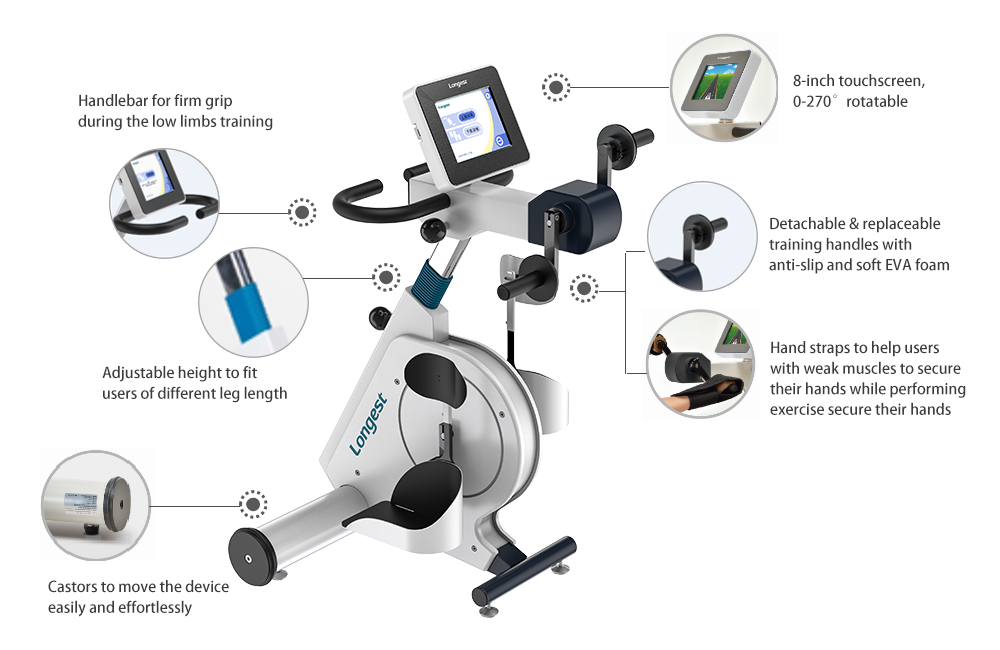Complete Guide: What is an Active Passive Trainer
Discover Longest’s Complete Guide: What is an Active Passive Trainer and learn how this innovative fitness tool enhances workouts. Explore benefits, uses, and tips to maximize your training results. Boost your fitness journey with expert insights in this comprehensive guide.
- Preface
- What is an Active Passive Trainer?
- Key Differences Between Active and Passive Training Modes
- How Does an Active Passive Trainer Work?
- Is an Active Passive Trainer Safe to Use?
- Who Can Benefit from Using an Active Passive Trainer?
- Precautions When Using the Active Passive Trainer
- Where to Buy Active Passive Trainer
- Conclusion
- FAQs
Preface
What is an Active Passive Trainer?
Key Differences Between Active and Passive Training Modes
| Feature | Active Mode | Passive Mode |
| User Involvement | Full participation in movement. | Machine moves limbs for the user. |
| Intensity Level | Higher intensity, focused on building muscle strength. | Lower intensity, focusing on relaxation and circulation. |
| Targeted Benefits | Increases muscle strength, joint mobility, and endurance. | Enhances circulation, reduces muscle stiffness. |
| Ideal for | Healthy individuals or those looking to build strength. | Those with limited mobility or recovering from injuries. |
| Mode of Operation | Active exercise, user initiates movement. | Passive assistance, machine moves limbs. |
How Does an Active Passive Trainer Work?

Is an Active Passive Trainer Safe to Use?
Who Can Benefit from Using an Active Passive Trainer?

-
Post-Surgery Patients: Ideal for individuals recovering from surgeries like hip or knee replacements. Helps restore movement, flexibility, and muscle strength during recovery.
-
Stroke and Neurological Patients: Assists in regaining motor function and improving coordination, crucial for individuals with neurological impairments or spinal cord injuries.
-
Chronic Pain Sufferers: Beneficial for those with arthritis, fibromyalgia, or other chronic pain conditions. Reduces stiffness, improves circulation, and alleviates pain without overexertion.
-
Elderly Individuals: Helps seniors maintain mobility, strength, and independence by providing safe, controlled movement therapy.
Precautions When Using the Active Passive Trainer
Where to Buy Active Passive Trainer

Conclusion
FAQs

The Definitive Guide to Shockwave Therapy Machines: Technology, Benefits, and Choosing the Best Device

Unlocking Deep Healing: The Definitive Guide to Focused Shockwave Therapy Machines

Longest Medical Concludes a Brilliant Journey at MEDICA 2025

LONGEST MEDICAL Shines at MEDICA 2025 with Innovative Rehabilitation Releases

World Diabetes Day: Longest Shockwave Therapy—New Hope for Diabetic Foot
High Frequency Therapy Device
What is the difference between Capacitive Mode (CET) and Resistive Mode (RET)?
Operation method: CET requires continuous movement of electrodes, while RET is a fixed operation; Target area: CET acts on superficial, high-moisture, low-impedance tissues (such as dermis, muscles, fascia), and RET targets deep, low-moisture, high-impedance tissues (such as ligaments, tendons, bones, joints).
2500s plus physical therapy version
What are the characteristics of the radial pulse wave therapy machine PowerShocker LGT-2500S Plus?
The PowerShocker LGT-2500S Plus is characterized by compact dimension, easy operation, reliability, and low maintenance.
Is acoustic wave therapy safe and what are the side effects?
Acoustic wave therapy is extremely safe. Minor side effects like mild bruising, swelling, pain, numbness, or tingling in the treated area may occur, but they recover quickly and don't affect daily activities.
LGT-2210DS
Is there a warranty period for the LGT - 2210DS device?
Yes, the LGT - 2210DS is covered by a warranty. For any issues, please contact our staff, and we will provide dedicated service to assist you.
Electrostatic Oscillation
How long does a treatment take? How long does it take to see the effect?
A single treatment usually lasts 15-20 minutes. The specific time to see the effect varies from person to person, depending on personal physical condition and treatment needs. Generally, after a few treatments, you can feel the initial effects such as pain relief and muscle relaxation.

Rehab Bike for Upper and Lower Limbs, Active-Passive Trainer (APT) RehaMoto LGT-5100D Config II
The RehaMoto LGT-5100D Config II is a rehabilitative training device designed to facilitate both active and passive movements of a person's lower and upper limbs. This device features four training modes: active-passive training, assistive training, symmetry training, and isokinetic training. Additionally, it is equipped with multiple protection functions, including spasm control, emergency stop, max. speed control, and speed setting prompt.

Rehab Bike for Upper and Lower Limbs, Active-Passive Trainer (APT) RehaMoto LGT-5100P
The RehaMoto LGT-5100P is an outstanding device that offers safe, engaging, and efficacious exercise opportunities to individuals whose mobility is restricted due to neurological conditions, injuries, surgical procedures, or musculoskeletal disorders. As an active-passive trainer for both the upper and lower limbs, it features five training modes and several protection mechanisms.
Moreover, it is crafted from top-notch materials with excellent workmanship and showcases a simple, contemporary, and stylish appearance. With its screen upgraded to the Android system, a wider range of applications becomes accessible, thus enhancing convenience and versatility.
Get in touch with us
© 2025 Longest Medical. All Rights Reserved. Powered by gooeyun.






LongestMedical
LongestGloba
longest
guangzhou_longest
GzLongest